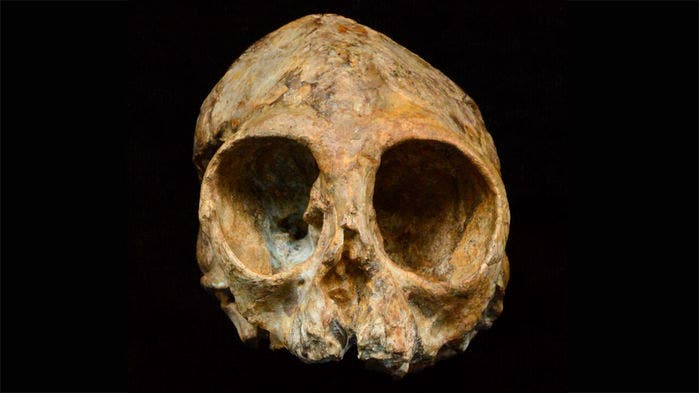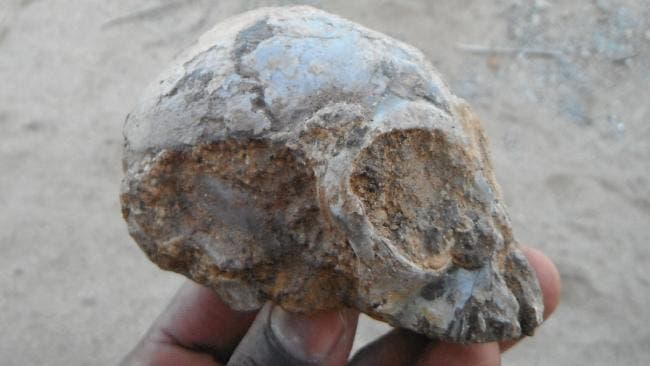An almost perfectly preserved, 7 million-year-old primate skull comes to fuel the debate around humanity’s cradle of birth.
Anthropologists have been dying to get their hands on fossil evidence of the human-ape evolutionary split ever since we figured out that it must’ve happened. Three years ago, on a dusty trail in Kenya, Providence might have delivered them just one such prize. The catch, however, is that the fossilized skull is about the size of a baseball and comes from an infant individual. So it’s a bit of a mixed blessing, as it can help us piece together a rough idea of what the common ancestor of humans and apes looked like — but does little to settle other debates.
A Lucky Find
The skull is surprisingly well preserved for its age and was found in the Turkana Basin, northern Kenya, some 3 years ago. The team, led by primate paleontologist Isaiah Nengo of De Anza College in Cupertino, California, were working with Kenyan fossil hunter John Ekusi on excavations close to Lake Turkana. It hadn’t been a decidedly average day until Ekusi walked back to the jeep to light a cigarette — and found himself in surprising company.
“There was this skull just sticking out of the ground,” Nengo recalls. “It was incredible because we had been going up and down that path for weeks and never noticed it.”
It obviously once belonged to a primate, and the researchers sent it to the Noble Gas Laboratory at Rutgers University in New Brunswick, New Jersey, for argon isotope dating, revealing that it was about 13 million years old. Turkana Basin was a lush rainforest during that time, an ideal habitat for apes and other primates.
The skull resembled that of a modern gibbon, Nengo says, but teeth shape and dental patterns tie it closer to one other genus of Miocene primates found in Kenya, Nyanzapithecus. The skull’s molars, however, are much larger than those of known nyanzapithecines, which suggested a new species altogether. The researchers named it N. alesi after the Turkana word for “ancestor.”
It was then sent to the European Synchrotron Radiation Facility in Grenoble, France, for extremely high-detail X-ray imaging study. This allowed the team to count growth lines in the skull’s (still unerupted) adult teeth. These indicated that the animal was about 485 days (or 1 year and 4 months) old when it died. The imaging also showed bony ear tubes embedded in the skull, which likely acted as a balance organ.
And those tiny little tubes have a big implication. Whether Nyanzapithecus was an ape or monkey line has been a hotly topic, but these tubes, along with the shape and size of the teeth, solidly mark N. alesi — and by extension all nyanzapithecines — as apes, the team reports. Even more, these tubes signal a direct link to the ape line from which humans and modern apes originate.
Bones plz
That’s a finding that could put a long-lasting debate of humanity’s birthplace to bed. Finding a common man-ape ancestor in Africa tips the scales heavily in favor of this continent. But the debate is far from settled, because what the tiny skull giveth it also taketh away.
The problem is that most headway in anthropology research is based on comparative analysis. That’s a fancy way of saying that anthropologists spend a lot of time comparing similar fossils to create an evolutionary roadmap. It works really well if you have fossils to compare — but that’s not the case here. We didn’t find any other infant Miocene-ape skull apart from this one. So although it could offer a link between modern human and ape ancestry, it leaves too much wiggle room. For example, we can’t meaningfully compare it to recently-found Graecopithecus, a similar early hominid/human-like ape which seems to hail from Europe. So while supporters of the out of Africa theory can point to N. alesi, their counterparts can rally around Graecopithecus — and it’s a stalemate again.
We simply need more fossil evidence to pinpoint humanity’s place of birth beyond a doubt. We may never be able to do it, considering how unlikely it is for bones to successfully fossilize. But considering the team found their skull literally sticking half-out from the ground, I’d say we have a fair bit of luck on our side.
The paper “New infant cranium from the African Miocene sheds light on ape evolution” has been published in the journal Nature.











